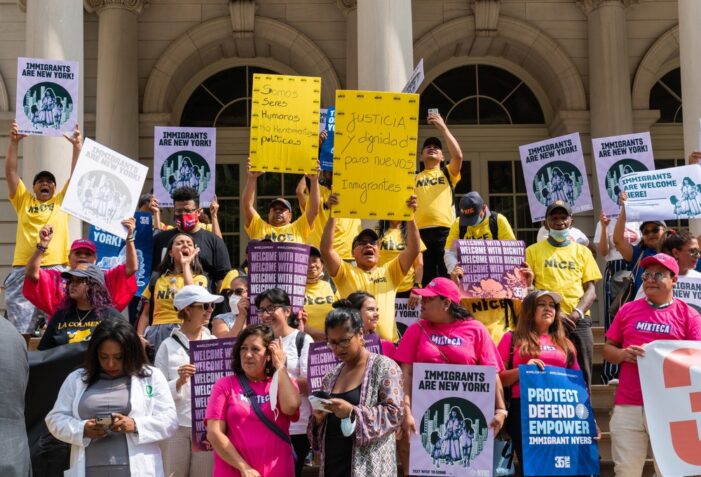New York City, NY USA August 26, 2022. NY Immigration Coalition held a press conference at City Hall demanding the city do more to help asylum seekers arriving in NYC. (Shutterstock)
By Fisayo Okare, Documented NY
Mayor Eric Adams positioned himself as a defender of immigrants rights on the campaign trail. Now he has a different message: don’t come to New York.
Over the past several months, Adams has faced one of the biggest challenges in his mayorship so far: the tens of thousands of migrants who have been bused to New York City. Adams said City resources and staff are overwhelmed due to the new arrivals, and he has sought assistance and solutions — including financial aid and policy changes — on both state and federal levels.
Adams says New York City has been stretched to its limits: at the U.S. Conference of Mayors in Washington, D.C., on Wednesday, he declared that “there is no room in New York” for more migrants — which, on a larger scale, reflects what the Biden administration has said. In June 2021, Vice President Kamala Harris addressed people in Guatemala who may potentially want to migrate saying: “Do not come.”
But despite these warnings, it’s become increasingly clear that telling migrants not to come does not hinder them as they flee from poverty and violence, or to reunite with their families.
Historically, Adams’ public statements have shown strong support for immigrant communities: The month before he won the Mayoral election, he released a plan to “protect immigrant communities.” And he has, so far, supported efforts to ensure some noncitizens can vote and to let undocumented residents get driver’s licenses.
But now in the face of pressure to better manage the City’s budget, he has changed his welcoming attitude.
New York City has a right to shelter law which requires it to provide shelter to anyone who seeks it; most U.S. jurisdictions do not have a similar law. In his trip this week to El Paso, Adams said that migrants are given a “false impression” of how this law works in New York, with a mistaken understanding that it’s a place where “resources are available.”
Advocates say Adams’ support for migrants has hit capacity: Murad Awawdeh, the executive director of the New York Immigration Coalition, said “it’s unfortunate that we’re now seeing [Eric Adams] take this line excluding part of the immigrant community.” He called the rhetoric “deeply divisive” and said “This is not a moment that the city should be trying to hold asylum seekers accountable for its own failures.”
NYC Comptroller Brad Lander has similarly criticized the Mayor’s trip to Texas in a tweet, saying: “It does little to deliver the $$ NYC needs to provide shelter & services. Instead, it risks reinforcing a harmful narrative that new immigrants themselves are a problem.”
Awawdeh said the real issue and crisis the City is facing is not a migrant crisis but a housing crisis. The city is “utilizing the shelter system as a stopgap, but shelter systems are supposed to be temporary. We need the mayor to focus on getting people who are in shelter right now into permanent housing,” Awawdeh said. The shelter systems have gotten even more full since the city’s eviction moratorium ended a year ago.
Awawdeh also disputed Adams’ characterization of the migrant arrivals as an “emergency,” saying the city has been “receiving people since April,” but still “not moving forward.”
Adams and New York Gov. Kathy Hochul are meanwhile contradicting each other’s stance on immigration in the state. While Hochul has been focusing on an outmigration crisis — stating a need to retain business and people in New York— Adams’ stance is that New York City is full, and Hochul hasn’t aligned with Adams’ proposal to move migrants to other cities within the state.
Adams’ budget announcements about helping migrants have continued to change: Just before he made the El Paso trip, Adams said New York City will need up to $2 billion to manage the crisis. Last year, he said it would cost $1 billion. But based on the number of asylum seekers who had arrived as of early November 2022, the city’s Independent Budget Office estimated the city will spend just $596 million to care for migrants over the course of a year.
Much of the $800 million the federal government recently approved for states, local governments and nongovernmental organizations dealing with the increase in migrants, is expected to be allocated to New York City.
Awawdeh said the City’s math hasn’t been math -ing. “We can’t keep saying there’s a lack of funding from the federal government,” he said, “because the federal government just re-upped $800 million to support cities and states that are supporting asylum seekers. So there’s money there.”
“It comes down to leadership and in this moment, we really need New York to lead as we always have on immigrants and supporting immigrants regardless of where they come from.”

